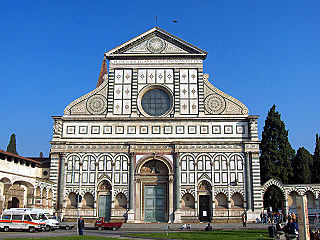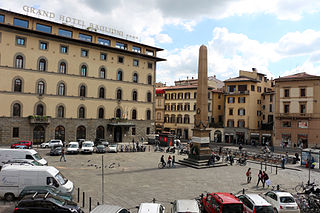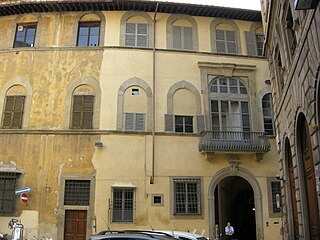
Florence is a city in Central Italy and the capital city of the Tuscany region. It is the most populated city in Tuscany, with 383,084 inhabitants in 2013, and over 1,520,000 in its metropolitan area.

Santa Maria Novella is a church in Florence, Italy, situated opposite, and lending its name to, the city's main railway station. Chronologically, it is the first great basilica in Florence, and is the city's principal Dominican church.

Florence Cathedral, formally the Cattedrale di Santa Maria del Fiore, is the cathedral of Florence, Italy. It was begun in 1296 in the Gothic style to a design of Arnolfo di Cambio and was structurally completed by 1436, with the dome engineered by Filippo Brunelleschi. The exterior of the basilica is faced with polychrome marble panels in various shades of green and pink, bordered by white, and has an elaborate 19th-century Gothic Revival façade by Emilio De Fabris.

Firenze Santa Maria Novella or Stazione di Santa Maria Novella is a terminus railway station in Florence, Italy. The station is used by 59 million people every year and is one of the busiest in Italy.
Villa del Poggio Imperiale is a predominantly neoclassical former grand ducal villa in Arcetri, just to the south of Florence in Tuscany, central Italy. Beginning as a villa of the Baroncelli of Florence, it was seized by the Medici, became the home of a homicidal and unfaithful husband, and a lavish retreat for a Grand Duchess with imperial pretensions. Later given to Napoleon's sister, it was reclaimed by the hereditary rulers of Tuscany before being finally converted to a prestigious girls' school. During its long history, it has often been at the centre of Italy's turbulent history, and has been rebuilt and redesigned many times.
Giovanni Antonio Dosio (1533–1611) was an Italian architect and sculptor.

The Palazzo Grimani of Santa Maria Formosa is a State museum, located in Venice in the Castello district, near Campo Santa Maria Formosa.
The Heating plant and main controls cabin is a technical facilities building in Firenze Santa Maria Novella railway station designed by architect Angiolo Mazzoni in 1929. The complex is recognized as one of the masterpieces of Futurist architecture.

The Hotel Laurus al Duomo is a hotel in Florence, in the historical Via de’ Cerretani, with a façade in Via dell’Alloro. The building is about 70 meters away from Piazza del Duomo, Florence, the Florence Cathedral and the Giotto's Campanile. The building is not far from the Basilica of Santa Maria Novella and from the Firenze Santa Maria Novella railway station. The building is also in front of the church of Santa Maria Maggiore, Florence. The building of the hotel is also the location of Auditorium al Duomo and of Cafè Astra al Duomo. The hotel, together with Hotel Pitti Palace al Ponte Vecchio, Auditorium al Duomo and Caffè Astra al Duomo is part of the system Centro Congressi al Duomo and shares the ethos Life Beyond Tourism.
Giuseppe Servolini, also known as Sorbolini, (1748–1834) was an Italian painter and engraver active mainly in Florence.
The Palazzo Viviani della Robbia is a Baroque-style palace located on Via de Tornabuoni #15, corner with Via della Spada, in the quartieri of Santa Maria Novella, city of Florence, region of Tuscany, Italy.

The Complesso di San Firenze is a 17th-century Baroque-style building, consisting of a church, palace, and former oratory, located on the southeast corner of the saucer-shaped piazza of San Firenze, located in the quartiere of Santa Croce in central Florence, region of Tuscany, Italy. The buildings were commissioned by the Oratorians of Saint Philip Neri.

The Obelisks of the Corsa dei Cocchi, or Aguglie di Piazza Santa Maria Novella are two 16th-century, four-sided, marble obelisk monuments located in the Piazza of Santa Maria Novella, Florence, region of Tuscany, Italy.

The Obelisk of the Fallen in the Wars of Independence in the Piazza dell'Unità Italiana, once called the Piazza Vecchia di Santa Maria Novella, is a monument located in the piazza just east of the apse of Santa Maria Novella, surrounded by large hotels and offices located near the main train station in Florence, Italy.

The Palazzo or Casa Martelli was a residential palace, and since 2009, a civic museum displaying in situ the remains of the original family's valuable art collection, as well as its frescoed rooms. The palace is located on Via Ferdinando Zannetti 8 near the corner with Via Cerretani in central Florence, region of Tuscany, Italy.
The Palazzo Tempi, also known as Palazzo Vettori or Bargagli Petrucci, is a palace located along the Arno river at the narrow Piazza Santa Maria Soprarno 1, corner with Via de' Bardi and Costa dei Magnoli in the Oltrarno section of Florence, Tuscany, Italy. The palace is across the river from the Galleria of the Uffizi, and a block east of the Ponte Vecchio. The Via de' Bardi originates in an arch under the building.

The "workshop" of Pietro Bazzanti and Son is an historic landmark in Florence, art and culture heritage of the city. It took part in the role of "Fine Arts Trader" at the National Exposition of 1861 in Florence with several marble sculptures and various other works. The Bazzanti Marble Studio won the medal for the category "sculpture".

Santa Maria della Neve al Portico is a Roman Catholic church and convent located on a rural site on Via del Podestà #86 in the suburban neighborhood of Galluzzo southeast of the urban center of Florence, Italy. It remains a monastery and is also known as the Convento Il Portico and now houses the Istituti Religiosi Femminili Suore Stimmatine.

The Palazzina Reale delle Cascine is a small Neoclassical palace sited on the Piazzale delle Cascine within the public park located along the north bank of the Arno river just north of central Florence, Italy. Built in the mid-18th century by the Lorraine Duke of Florence, in 2020 now houses part of the offices of the faculty of agricultural and forestry sciences of the University of Florence.
















